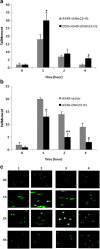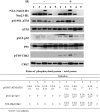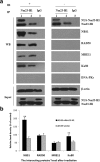Nm23-H1 is involved in the repair of ionizing radiation-induced DNA double-strand breaks in the A549 lung cancer cell line
- PMID: 29970055
- PMCID: PMC6029351
- DOI: 10.1186/s12885-018-4592-2
Nm23-H1 is involved in the repair of ionizing radiation-induced DNA double-strand breaks in the A549 lung cancer cell line
Abstract
Background: Although originally identified as a putative metastasis suppressor, increasing studies have confirmed a possible role for Nm23-H1 in DNA repair, through the base excision repair and nucleotide excision repair pathways. In this study, we explored whether Nm23-H1 was also involved in double-strand break repair (DSBR).
Methods and results: We constructed a stable A549-shNm23-H1 cell line with doxycycline-regulated expression of Nm23-H1, and a A549-nNm23-H1 cell line that over expressed a nucleus-localized version of Nm23-H1. Results from both lines confirmed that Nm23-H1 participated in the repair of double-strand breaks induced by X-rays, using Comet and γ-H2AX foci assays. Subsequent studies showed that Nm23-H1 activated the phosphorylation of checkpoint-related proteins including ATM serine/threonine kinase (on S1981), tumor protein p53 (on S15), and checkpoint kinase 2 (Chk2) (on T68). We also detected interactions between Nm23-H1 and the MRE11-RAD50-NBS1 (MRN) complex, as well as Ku80. Moreover, NBS1 and Ku80 levels were comparably higher in Nm23-H1 overexpressing cells than in control cells (t = 14.462, p < 0.001 and t = 5.347, p = 0.006, respectively). As Ku80 is the keystone of the non-homologous end joining (NHEJ) pathway, we speculate that Nm23-H1 promotes DSBR through NHEJ.
Conclusions: The results indicate that Nm23-H1 participates in multiple steps of DSBR.
Keywords: Double-strand break repair; Lung cancer; Nm23-H1.
Conflict of interest statement
Ethics approval and consent to participate
Materials and cell lines used in this study don’t require an ethical approval.
Consent for publication
Not applicable.
Competing interests
The authors declare that they have no competing interests.
Publisher’s Note
Springer Nature remains neutral with regard to jurisdictional claims in published maps and institutional affiliations.
Figures







Similar articles
-
Metastasis Suppressor NME1 Modulates Choice of Double-Strand Break Repair Pathways in Melanoma Cells by Enhancing Alternative NHEJ while Inhibiting NHEJ and HR.Int J Mol Sci. 2020 Aug 17;21(16):5896. doi: 10.3390/ijms21165896. Int J Mol Sci. 2020. PMID: 32824412 Free PMC article.
-
Nm23-H1 protein binds to APE1 at AP sites and stimulates AP endonuclease activity following ionizing radiation of the human lung cancer A549 cells.Cell Biochem Biophys. 2011 Dec;61(3):561-72. doi: 10.1007/s12013-011-9238-9. Cell Biochem Biophys. 2011. PMID: 21769563
-
Metastasis suppressor NME1 promotes non-homologous end joining of DNA double-strand breaks.DNA Repair (Amst). 2019 May;77:27-35. doi: 10.1016/j.dnarep.2019.03.003. Epub 2019 Mar 4. DNA Repair (Amst). 2019. PMID: 30875636
-
Regulation of DNA double-strand break repair pathway choice.Cell Res. 2008 Jan;18(1):134-47. doi: 10.1038/cr.2007.111. Cell Res. 2008. PMID: 18157161 Review.
-
Multiple mechanisms underlie metastasis suppressor function of NM23-H1 in melanoma.Naunyn Schmiedebergs Arch Pharmacol. 2011 Oct;384(4-5):433-8. doi: 10.1007/s00210-011-0621-2. Epub 2011 Mar 30. Naunyn Schmiedebergs Arch Pharmacol. 2011. PMID: 21448569 Review.
Cited by
-
Nuclear NME1 enhances the malignant behavior of A549 cells and impacts lung adenocarcinoma patient prognosis.iScience. 2024 Jun 15;27(7):110286. doi: 10.1016/j.isci.2024.110286. eCollection 2024 Jul 19. iScience. 2024. PMID: 39055952 Free PMC article.
-
NSUN6 Regulates NM23-H1 Expression in an m5C Manner to Affect Epithelial-Mesenchymal Transition in Lung Cancer.Med Princ Pract. 2024;33(1):56-65. doi: 10.1159/000535479. Epub 2023 Nov 29. Med Princ Pract. 2024. PMID: 38029727 Free PMC article.
-
Decreased expression of EFCC1 and its prognostic value in lung adenocarcinoma.Ann Transl Med. 2019 Nov;7(22):672. doi: 10.21037/atm.2019.10.41. Ann Transl Med. 2019. PMID: 31930073 Free PMC article.
-
Role of Trypanosoma cruzi nucleoside diphosphate kinase 1 in DNA damage responses.Mem Inst Oswaldo Cruz. 2020;115:e200019. doi: 10.1590/0074-02760200019. Epub 2020 Jul 15. Mem Inst Oswaldo Cruz. 2020. PMID: 32696913 Free PMC article.
-
Expression of nm23-H1, p53, and integrin β1 in endometriosis and their clinical significance.Int J Clin Exp Pathol. 2020 May 1;13(5):1024-1029. eCollection 2020. Int J Clin Exp Pathol. 2020. PMID: 32509074 Free PMC article.
References
MeSH terms
Substances
Grants and funding
LinkOut - more resources
Full Text Sources
Other Literature Sources
Medical
Research Materials
Miscellaneous

